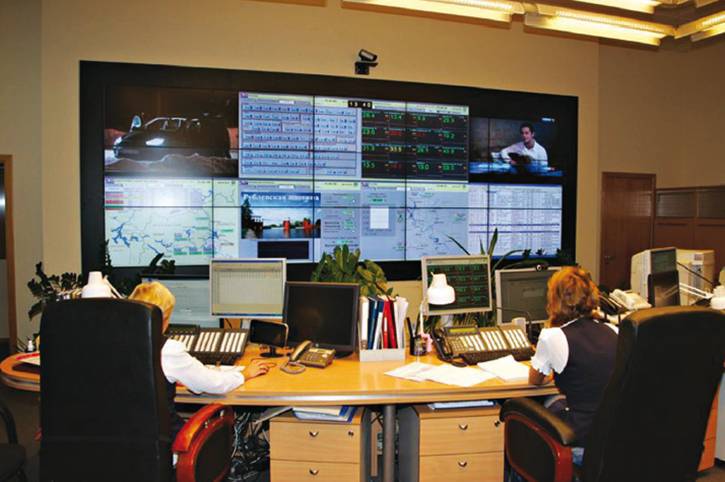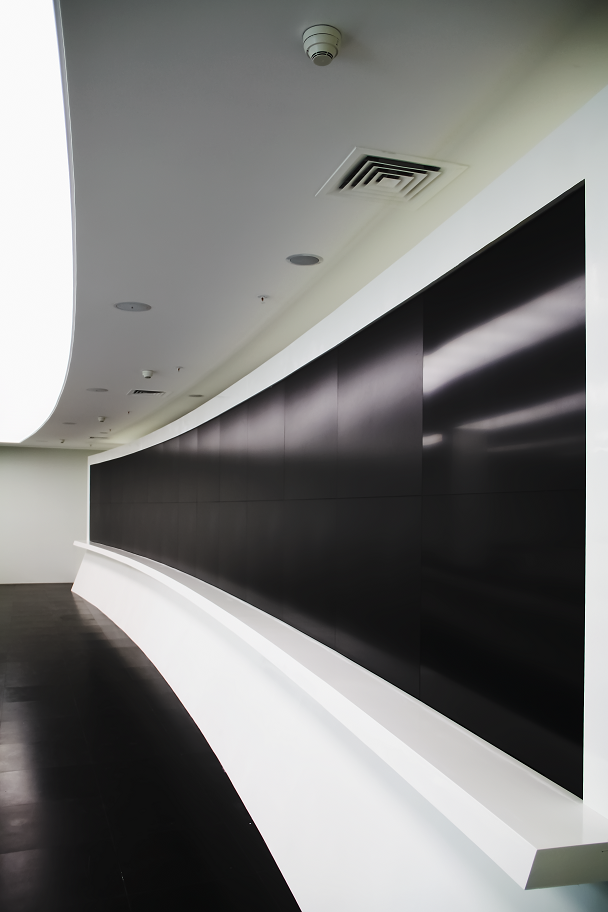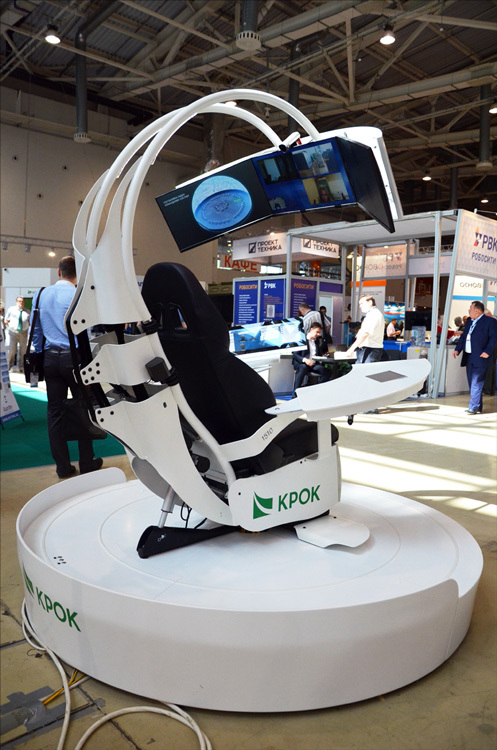How we do command and situational centers for large companies.

Individual command center capsular type: anatomical chair, panoramic monitor, control panel, video and audio communication, special software.

Decision Center OJSC "Mosvodokanal"
Komcenter or, as they are correctly called, situational centers - this is a room well familiar to you from fantastic films. There is usually a big beautiful video wall where you can watch the communists take over the world - or how the trains tend to collide with each other. In practice, of course, the use of SCs is much more prosaic, but shots also occur as in films.
')
Application
The general meaning is this: a large video wall in a regular situation shows everything that is long and difficult to open with your hands. For retail and passenger companies, for example, flows from cameras, for construction sites — webcams of buildings and a map with truck traffic, for transport coordination — a huge line diagram with composition labels, for atomic enterprises — indicators of critical sensors and analytics, plus video of “hot” ones zones and so on. Operators sitting in front of such a wall simply gaze at it from time to time to see the whole picture. Of course, theoretically, they can open the same video streams and applications on their screens, but the meaning of a video wall in the usual time is that all the information in one place is always visible.
In a critical situation , the following usually happens. Suppose some sensor generates an alarm, for example, on an atomic object. The wall will immediately switch to the alarm mode: everything that was shown before will go to the sides and be small, and in the center there will be data from the alarm object, camera feeds and analytics on it. Most often, an alarm will show a complex area automatically, so that within 1-2 seconds you can understand what is happening and begin to respond.
Here is a very simplified layout of the standard mode:

And here is an emergency response:

This is one of the simplified "Safe City" templates. The analytics camera monitors forgotten things (objects that appeared recently in the frame and do not move) - in this scenario, the forgotten bag at the station is displayed on the screen.
In addition, each of the operators can use part of the screen for their tasks, for example, to withdraw large numbers of indicators or telemetry of something specific at the request of the manager.
There is also an analytical mode, when such centers are used for a comprehensive study of the situation by a commission - and you need to keep a lot of information before your eyes.
Architecture
A typical situational center consists of rather simple components.

1. Display Tool
As a rule, it is a big screen from projection cubes, or assembled from LCD panels with a thin frame. Also used stitching projectors, but much less.
This is an example of a screen of LCD panels:

And this is how a video wall from cubes looks like.

2. Video wall control controller
On the big screen comes a variety of data. As a rule, in the usual mode these are video streams from cameras, indicators from various sensors, conclusions of customer’s applications, and so on, plus various indicators of analytics, sometimes video calls and other multimedia data.
The controller provides switching of all streams, transformation, analytics applications and customer application outputs are “spinning” on it. Also, right on it work out emergency scripts that put important objects in the spotlight.
Controller control is implemented on a separate touch panel (or all operators can have this functionality, taking into account the differentiation of rights). Here is one simple example:

It is also possible to organize emergency response scenarios, for example, not only displaying data in focus, but immediately calling all the right people (including a guide to their phones), collecting and sending data to those responsible, connecting all the right people to a single channel for discussion. When you sit at home and drink tea, and something happened at the facility, you will have a diagram and telemetry on the tablet in 10 seconds, and communication with the center and the necessary personnel of the facility after 12-15.
3. Operators jobs
As a rule, the workplace of the operator of the situational center is not much different from the usual office workplace. In recent years, more and more often they put two screens on the user, plus sometimes the hardware controls the transfer of the image of your screen on the video wall, when you need to quickly show something to everyone.
In large centers, the operator’s workplace is completed with an intercom to communicate with all other operators, or, again, the opportunity to loudly convey something important to the whole group right from the spot. Since usually the centers and SCs are equipped with a “heavy” video conferencing piece of iron, right there a bunch of all operators are made into a single system - you can go on the screen with your face and bring something.
Authorization in the workplace of operators is usually done by RFID or other similar methods. As a rule, biometric authorization at the entrance to the center and authorization with a dongle at the workplace are combined.
Very often, operators have the opportunity from their workplace to connect to the computer control at the facility or to the computer of one of their colleagues - this is done to simplify collaboration.
4. Auxiliary equipment
A lot of equipment is used for switching, converting, capturing images, sound, and so on. In general, all this is in the diagram above and does not require a separate explanation. One has only to add that for the responsible objects a scheme is used where the failure of any node does not stop the operation of the center - as a rule, everything has been duplicated.
Modes
Daily routine
The monitoring and research regime, when the current problem is monitored on a long-term basis, which consists in developing possible ways of achieving the goal, monitoring the situation. An example is the observation of atomic objects in the normal mode.

Regular monitoring of the collection in the bank: there may be a picture of the current collection, a map with transport, statistics, a card with an accident, and various reports.

Normal mode of monitoring objects

Regular mode of the individual command center: video conferencing, object map, video analytics.
Planning operational activities
Based on a pre-formalized knowledge of precedents (for example, typical reactions to different types of emergencies) and previously accumulated information about what is important in such situations, ready-made, pre-developed and approved by the management general solution algorithms are used. This mode is often used by oil and gas companies: there is a lot of analytics there, and it’s very convenient to see everything on the video wall.

SC Atomenrgoproma mode VKS. In the video stream, any of the operators can show their analytical data.
Work in crisis situations
An emergency or real-time mode, when there is no formalized knowledge of precedents, there are no ready-made management algorithms, and the time limit is very limited. This is the very mode of the situational center, which is usually shown in films. If you exclude special effects, it is approximately the same.

These familiar notifications are also controlled from the situation center.
"Heavy" software part
With software situational centers is much more complicated than with iron. Here's what besides the usual solutions can be inside:
- Consolidation of internal and external sources into a single information space.
Simply put - Big Data for later analytics. Plus auto-informing. For example, the engine collects all media data on a problem, tweets and mentions in other social networks, BI analyzes emotional tints, and if for a particular region it drops sharply, a notification is generated for the operators of the situational center. In addition, in emergencies, a properly selected social network tape helps to get real-time reports from independent witnesses.
If we are talking about a geographically-distributed enterprise, the system monitors and analyzes the indicators coming from disparate sources, compares them, identifies atypical situations that lead to failures, emergencies, simulates different state and emergency situations.
This improves the quality of decision-making, again, reduces the reaction time, but requires quite serious costs for software, implementation, and hardware.
- Commercial analytics.
This is a multi-factor analysis of financial indicators, KPI, personnel, customers, and so on - such BI is very important as a source of information for making strategic decisions, for example, on the market. While other companies do it by sight, the commission at the decision-making center can get a comprehensive analysis for each client (of which there may be thousands in the country) based on extrapolation of data from previous years, overlaying market trends and other trends. As a result, where the rest work with the trend, people with BI tools work with specific, albeit very large data. Which is much more accurate than the finger-to-nose method. It is clear that much more often BI is used for more mundane purposes - quick reports in real time on indicators of interest, gathering information from various sources and its consolidation, independence from the IT department during analytics. It turns out a kind of single source of truth about the finances of the company and its condition.
- Voice control.
This is a simple trick to speed up the management of a situational center, my colleague has already written about it in more detail in a post about “Yeeeeee!” And speech recognition problems.
Why is all this necessary
In fact, the center or the situational center collects all the important information in one place, plus it allows you to focus on emergency situations. General purpose - speeding up the reaction, convenience of general work, making the right decisions. Less often - situation forecasting and analytics. In the normal mode - monitoring.
I have been involved in the design, installation and commissioning of civil decision-making centers for a little more than four years. During this time, our team has done a lot for state-owned companies in the oil and gas, nuclear, transport, financial and industrial sectors. All centers are now working on a regular basis, and display a variety of information - from the pressure at Mosvodokanal nodes to data from sensors in the nuclear industry.
If you are interested in learning more about SC or ICC for your object, ask, I will answer with pleasure. If the question is private, here is my email - EBogdanov@croc.ru.

And we are testing this in our office another device, sometimes supplied for situational centers. Guess what it is and what is it for?
Source: https://habr.com/ru/post/243699/
All Articles